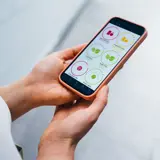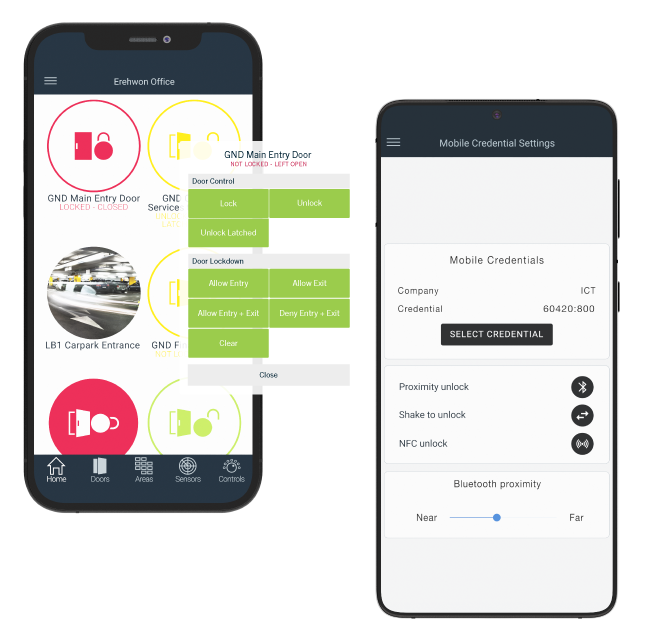
Mobile Access Control Systems
Access and control.
In the palm of your hand.
Mobile Access - How it Works?
Mobile access uses smartphones, tablets, or smartwatches to manage access to buildings and secure areas. Equipped with Bluetooth® wireless technology and NFC capability, our latest tSec readers work with the Protege Mobile App and Mobile Credentials, enabling you to unlock doors to buildings and secure areas, replacing other access control methods such as physical cards or keys. This system provides flexibility, security, and efficiency for controlling access.

Mobile Control
Control your site from your smartphone.
Use the Protege Mobile App to monitor and control your business while on the go, all from the touch of your smartphone. With the swipe of a finger, you can connect to any of your sites, check the status, arm or disarm, control lights, locks, signage, and heating from anywhere, at any time. The app integrates seamlessly with mobile connect software interfaces, enhancing security and convenience by allowing you to replace traditional access cards with your mobile device.
Mobile Credentials - What are they?
Mobile Credentials are virtual credentials that provide card-free access via a smartphone as part of a mobile access control solution.
As an end user, mobile credentials provide the flexibility and added convenience of card-free access from a mobile device. No more issues with lost or forgotten cards and tags. Simply present your smartphone within range of the reader to gain entry. Customize the read range, and you don’t even need to take your phone out of your pocket.
As an integrator, mobile credentials eliminate the time spent handling physical access cards, and with everything managed online, there’s no shipping so customers can access them immediately. Multiple credentials can be stored on a single device – which is great for those managing multiple sites.

Key Benefits

Effortless Mobile Credentials
Streamlined Access for New and Temporary Employees: Mobile credentials are sent via email so new employees can hit the ground running. Set the date range from when the credentials should be available - stress-free solution for temps and fixed -term employees

Stop Credential Sharing
With Secure, Non-Transferable Mobile Access. Built-in measures stop users from forwarding their mobile credentials and users are much less likely to share their phones, stopping credential sharing in its tracks.

Eco-Friendly and Cost-Effective Access Solutions
Easily decrease your environmental impact and take the steps to making your place sustainable by switching to plastic-free mobile credentials.

Hassle-Free Credential Management
For for employees and tenants. Revoking credentials for former employees and tenants is easily managed by Protege. No more hoping they remember to bring the access card or key back.

Seamless Advanced Technologies
With Bluetooth and NFC Integration. Bring your own device with hybrid readers capable of recognizing NFC for Android and Bluetooth for IOS and Android devices.

Multi-Layer Security for Lost or Stolen Devices
If the phone is lost or stolen, several layers of authentication and built in measures against attack keep your site security secure

Future-Ready Access Control for Modern Businesses
1 in 5 people reported losing an access control card in 2019. The loss of a smartphone is likely to be noticed immediately and acted upon.

One-Time Purchase Mobile Access Solution
No subscription fees, no ongoing costs. One-time only purchase.

Protege Mobile SDK
The ICT Mobile Software Development Kit (SDK) is a valuable tool for combining access control functionality with an existing app, using ICT mobile credentials. By providing access to our mobile APIs and services, we make it possible for developers to build integrations allowing third-party apps to access and transmit mobile credentials for use with ICT readers and access control systems.
Mobile Credential Portal
Managing mobile credentials is easily done with ICT’s Mobile Credential Portal.
Effortlessly assign credentials - all you need is an email address. This will prompt the user to install the ICT Protege Mobile app, which is where they access the credential from then on.
Revoke credentials from the portal quickly and simply. If a user leaves the business, all you need to do is click on the credential and select revoke.

Use Cases

Compatible Readers
ICT mobile credentials are available using near-field communication (NFC) technology for Android devices and can be used with any 13.56MHz readers. Bluetooth® credentials are available for Android and iOS devices and can be used with any Bluetooth® (BT) capable reader.
tSec readers that are compatible with mobile credentials can also be used with physical access cards and fobs, enabling you to migrate to a modern solution at your own pace or to embrace hybrid options.
Common Types of Mobile Access Control Technologies
Mobile access control systems utilize a variety of advanced technologies to ensure secure and convenient access. Some of the most common technologies include:
- Bluetooth Low Energy (BLE): BLE allows mobile devices to communicate with access control readers over short distances. This technology is energy-efficient and widely supported by modern smartphones, making it ideal for mobile access control systems.
- Near Field Communication (NFC): NFC enables close-range communication between mobile devices and access control readers. It is commonly used in contactless payment systems and provides a quick and secure way to transmit mobile credentials.
- Mobile Apps: Dedicated mobile apps provide users with a convenient interface to manage their access credentials, receive notifications, and control access points. These apps often integrate with other security systems, offering a comprehensive mobile access solution.
By combining these technologies, mobile access control systems deliver a robust and user-friendly solution for managing access in various environments.
Available Resources
Explore more about mobile credentials or how you can add the mobile credential right to your own app with our Mobile SDK.























